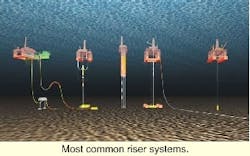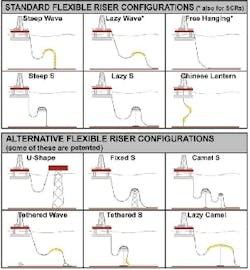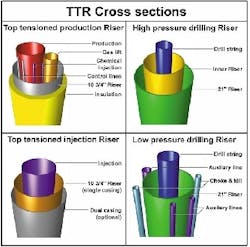DEEPWATER E&P: Dynamic risers key component for deepwater drilling, floating production
Terje Clausen
Halliburton Subsea/KBR Offshore Technology
Richard D' Souza
KBR Offshore Technology
Riser systems are a key component for offshore drilling or floating production projects. The cost and technical challenges of the riser system increase significantly with water depth. The cost of a riser system for a large drilling and production platform in deepwater will be in the same order of magnitude as the hull and mooring system.
The number of dynamic risers is growing proportionally to the increasing number of sanctioned or planned floating production units, particularly in the new deepwater areas of West Africa, the Gulf of Mexico, and Brazil, where significant investment is expected.
This article presents the results from a worldwide survey of existing, new, and alternative dynamic riser concepts for production and drilling on floating structures. The survey was completed in March 2001 by KBR Offshore/Halliburton Subsea for Offshore Magazine, and is based on interviews and data provided by about 100 riser suppliers and users. The database compiled from this survey is current and comprehensive, and the survey results are compiled in the accompanying pull-out poster.
The survey and poster provide an objective look at the dynamic riser systems and components presently available to the industry. Riser components presented on the poster are typical examples from suppliers. Several variations may exist.
The survey identified more than 1,550 production risers and 150 drilling risers in use today on floating units. As much as 85% of the production risers are flexibles. More than 90% of the drilling risers are "low pressure" with flange/dog type couplings. Flexibles are in use today in water depths up to 1,360 meters, and top tensioned risers (TTR) and steel catenary risers (SCR) are being used in depths up to 1,460 meters.
Drilling risers have been delivered for use in water depths greater than 3,000 meters, and are more standardized than the production risers. The deepest use of a production riser is a combined drilling and early production riser in 1,853 meters water depth on the Roncador Seillean floating production, storage, and offloading (FPSO) vessel off Brazil.
The geographical distribution is as follows: flexibles are installed in Brazil, the North Sea, and the Far East; TTRs are installed in the Gulf of Mexico and the North Sea.
The riser survey identified more than 50 emerging concepts under development for deepwater and ultra-deepwater applications. These concepts can be organized into roughly 10 groups. The most common are towers, hybrids, and those using lighter materials, all providing reduced topside loads. Characteristics of these emerging riser systems will be discussed later in the article. The stages of development, diameter and water depth ranges, and installation methods are tabulated for each concept.
Technology challenges
A riser system is much more than just a pipe. Design of a riser system for deepwater is a complex iterative multi-discipline process, with many variables. Depending on field layouts, vessel interfaces, fluid properties, and environmental conditions, a riser system is engineered for each particular application supported by prerequisite analysis, material, and testing pre-qualification. An extensive inspection and replacement program is standard for drilling risers.
Experience gained in designing riser systems for floaters in moderate water depths (200-400 meters) worldwide is being transferred to the deepwater projects. These moderate-depth systems are now being redesigned and stretched to work in deeper water.
The major deepwater challenges are the high hydrostatic pressure, prediction of riser loads and response, flow assurance, increased top-tension, and designing for economical installation.
For drilling, an additional challenge is the ability of the formation to withstand pressure from the enormous weight of mud in the riser. Therefore, a large number of new dynamic riser solutions have been presented to the industry over the last few years.
The increased cost and risk associated with deeper water has refocused attention on the riser and its components. R&D programs and joint industry projects (JIPs) are investigating numerous issues including:
- Vortex-induced vibration (VIV) response
- Riser-soil interaction
- Flow assurance
- Fatigue
- Use of new lighter materials
- Insulation materials and buoyancy elements for deepwater
- New analysis techniques (coupled analysis and optimization of the mooring and riser systems)
- Pipe-in-pipe (PIP) arrangement
- Installation methods.
Preventing wax and hydrate formation are critical elements in deepwater risers and flowlines. Increased insulation requirements and/or heating may be specified, with K-values sometimes as low as 1 W/degree C sq meter. Towers and PIP-risers can normally meet these requirements, due to their high insulation properties. Flexibles and steel pipe often need extra insulation or heating (electrically or fluid circulation).
Designing a riser system for a floating production system (FPS) in shallow water (less than 100 meters) is a unique challenge. Such systems need to be extremely flexible, in order to account for vessel motions.
Flexible risers
Flexible dynamic risers are an enabling technology for producing oil and gas from offshore wells using floating production systems. Flexibles are manufactured in accordance with API specification 17J and are produced by three companies today: CSO, Wellstream, and NKT. A new startup company for flexibles using composite materials is Deepflex. The main advantages of flexibles are:
- Large experience database (well proven)
- Flexible (robust in high dynamic environments)
- Easy to install and retrieve (low risk)
- Can be pipe-in-pipe or heated in the near future
- Corrosion resistant and reusable
- Can be installed along with the associated flowline.
Flexibles are designed in approximately 12 different configurations. Eleven of these are used today. The most common configurations are the "lazy wave" and "lazy S."
One of the largest deepwater (800-1,000 meter depths) field developments today using flexible risers is Petrobras' Barracuda Caratinga project, where Halliburton (Wellstream) will deliver more than 80 risers in 2003/2004. Experience from previous large riser projects such as Troll B and Troll C (Coflexip Stena Offshore and Wellstream) are actively incorporated.
The flexible pipe structure itself is standardized with minor differences from manufacturer to manufacturer. At the FPS, the riser is terminated through I/J-tubes, and protected from overbending by a bend-stiffener. The buoyancy is either discrete elements of syntactic material or a buoyancy tank (mid-water arch) of steel or elements of syntactic material.
Near the seabed, the riser is sometimes protected against impact and abrasion with half shells of polyurethane. Bend restrictors may be used at the end-terminations to protect the pipe form over-bending during installation. Major manufacturers of these ancillary components for flexibles include CRP, Orcina, and Balmoral.
Remarkable advances have been made in the development of un-bonded flexible pipe structures from first use offshore about three decades ago. As early as 1990, flexible pipe had been installed for dynamic application in water depths to 1,000 meters. Today, flexible risers are qualified for more than 1,500 meter depths, and are expected to reach 3,000 meters by the year 2002.
Further development programs are in place for reducing weight (by employing composite tensile armor), increasing the diameter envelopes for deeper water (targeting 12 in. in 2,500 meter depths by the year 2002), and improving flow assurance properties (by heating, advanced insulation materials, and smooth bore design). The price of flexibles has dropped significantly over the last 10 years due to increased competition, manufacturer development, and the introduction of SCRs.
Top-tensioned risers
TTRs are mostly used in connection with platforms (TLPs and Spars), supporting surface trees and blowout preventers (BOP). They are designed to accommodate the full well shut-in pressure.
A key component for the TTR is the tensioning system. Typically, hydro-pneumatic tensioners are used for drilling risers on Spars, TLPs, and production risers on TLPs. The production risers on Spars are kept in tension by air cans, which can be integral (structurally part of the riser) or non-integral. The keel joint between the riser and Spar is designed to accommodate the relative motion. Flanged couplings are used between the joints for the Spar drilling risers, while threaded connectors are used for Spar and TLP production and drilling. Stress joints are used near the seabed (above the tieback connector) to reduce stress levels.
The "mixed string" concept has recently been introduced to reduce TTR cost. The concept consists of lower cost couplings in the low stress/fatigue regions in the middle of the string. To date, the concept has been used on one Spar and one TLP.
Steel catenary risers
The number of SCRs is increasing rapidly, due to simplicity, cost effectiveness, and well-known material properties. In addition, they can accommodate large diameters and high temperatures. They can be configured as pipe-in-pipe (PIP) and can be heated to meet the enhanced insulation needs of deep water.
In the Gulf of Mexico, BP plans to install 25 SCRs on a semisubmersible for the Crazy Horse development in 1,900 meters water depth. This includes SCR diameter up to 24 in., which will be the world's largest for a floating unit.
Shell is planning to use PIP-SCRs with potential for electrical heating for the Nakika semisubmersible in 1,700 meters water depth. This will be the first non-Spar/TLP with SCRs in the Gulf of Mexico. Further, Shell recently awarded a contract to Stolt Offshore for installing eleven SCRs on the Bonga FPSO off West Africa. These will be the first SCRs used on a ship-shape structure.
The SCR is connected to the floater by a flexible joint or a tapered stress joint of steel or titanium. The top angles normally are between 10-20 degrees. Vortex-induced vibration (VIV) suppression devices (helical strakes) are often attached to the upper part of the riser.
SCRs are normally supplied by pipelay contractors, based on design and specification supplied by the operator or a specialist riser analysis consultant. Mechanical connectors, such as threaded joints, have recently been proposed for SCRs to ease the installation and use of weld-less connectors in areas of high fatigue.
Low-pressure drilling risers
The "classical" low pressure drilling riser consists of riser joints with clamped-on choke, kill, and auxiliary lines mounted to a subsea BOP via an adapter and flexible ball joint. The latter reduces the bending moment at the wellhead.
Lengths of the riser joints vary, depending on the rig's design and/or capability. Buoyancy modules are attached to the upper part of the riser, below the telescopic and termination joints. There are three types of riser-joint connectors: flange, dog, and the relatively new split ring (C-ring) type. All drilling risers require a tension system in order to provide a constant tension on the riser string to prevent buckling. Main drilling riser manufacturers are ABB, Cameron, and Shaffer.
Emerging configurations
The survey identified about 10 groups of new alternative concepts:
- Riser tower: This group consists of a riser-base pile, a bundle towed, buoyancy elements and/or cans, and flexible jumpers between the bundle top and the vessel. This concept has been used twice in the Gulf of Mexico in 500-700 meter water depths, and is now being installed in West Africa (Girassol at 1,440 meter depths). The advantages of this concept are: good insulation, heating lines may be incorporated, small subsea footprint, onshore fabrication, and low vessel loads. Another concept variant is to connect the tower directly to the FPS, via a yoke arrangement (Stolt Offshore), or simply to use low weight materials to reduce the buoyancy costs (Aker).
- Hybrid riser: This group recognizes the use of two different riser pipe materials, normally separated with a buoy and located 100-200 meters below the mean water level. The hybrids are currently designed for 500-3,000 meters water depth. The main advantages are reduced topside loads and ability to work in harsh environments. None are installed yet. An alternative consists of flexible pipe at the top and near the touchdown region with steel pipe in between (CSO), which is reelable.
- Spoolable composites: This group of production risers currently are being developed by ABB. CSO and Wellstream have developed carbon fiber tensile armor for use in flexibles, replacing the steel tensile armor. All these initiatives will reduce the riser tension at the floater.
- Integral flexible risers: This group currently is marketed by CSO, Kv
Conclusion
As field developments progress into increasingly greater water depths, the ability of the riser systems to drill, produce, and export fluids between the seabed and floating platforms will provide the principal challenge to the industry.
The riser survey demonstrated that riser contractors are actively engaged in design and development of a variety of innovative, robust, and competitive new riser systems, as well as improving the existing systems. Riser solutions have evolved to the point that the challenge now is how to select the best riser solution for the application.
Author
Terje Clausen is a Senior Technical Advisor at Halliburton Subsea/KBR Offshore Technology, with 13 years experience in deepwater risers, moorings, floating structures, and marine operations. He holds a BS and MS in Marine Technology from the Norwegian University of Science and Technology (NTNU).
Richard D'Souza is a Vice President in KBR Offshore Technology. He has been involved in the design and development of deepwater floating production and drilling systems for 27 years. He holds a BS and MS in Naval Architecture, and a MS in Structural Engineering.




